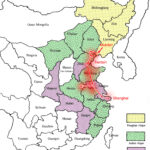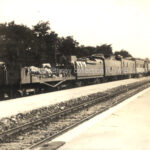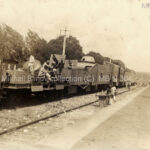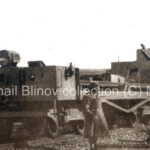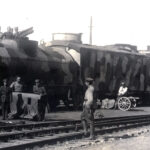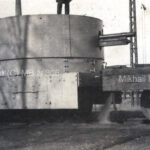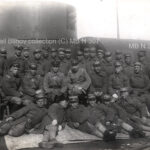“White Russian Armored Trains in the Chinese Civil War 1924-1928,″ by Mikhail Blinov. History, description, photo gallery by the author’s archives in Paris, 2003-2023.
Russian armored trains in the Chinese army.
In autumn 1924, during the second war of Zhang Zuoling against Wu Peifu, the Russian detachment began a campaign through the Jehol Mountains, bypassing the enemy garrisoning the Great Wall of China. Having successfully forced the enemy to retreat, either through maneuvering or a skirmish, the Russian detachment went deep into the rear and occupied the Lanzhou railway station (see the area below Shanghaiguan on the map). As trophies, they captured the railway station’s rolling stock, consisting of flatcars and wagons.
Since the time of the civil war in Russia, Russian officers have had extensive experience in building and using armored trains of various types, including improvised and ersatz ones. During the day, the first two “armored trains” were built at the Lanzhou station for use in a further offensive from the rear to the important city of Shanghaiguan. Cannons were installed on the flatcars, and machine guns were placed in the wagons. The firing positions were protected with sandbags. Due to their improvised construction, these trains are better referred to as “protected” instead of “armored”. The first protected train went to Shanghaiguan to demand the enemy’s surrender and instead received its first combat action. While approaching the city’s train station, someone sabotaged the railroad switches, and when the armored train was moving backwards, the rearmost flatcar jumped off the rails. The train was forced to defend itself for hours in a compromised position while work parties recovered the flatcar and repaired the rails. However, after this incident Shanghaiguan was taken without further fighting. The Russian detachment continued its advance first towards Tianjin, then further south towards Nanjing.
Jinan Military Camp and the Workshops
After the occupation of the city of Jinan, which became the main base of the Russian detachment for several years, real armored trains were built. Since 1910, good workshops for the manufacture of railway equipment have been located in the city of Jinan, which made it possible to rapidly armor flatcars and wagons, as well as provide the steady flow of spare parts needed to maintain and repair the armored trains. The first two trains were armed with 1 cannon, 4 machine guns and 1 mortar (“bomb thrower”). The entire first series of armored trains was primitive, and were called the “flat” or “box” type.
- Map of the battles of the Russian detachment for 1924-1925
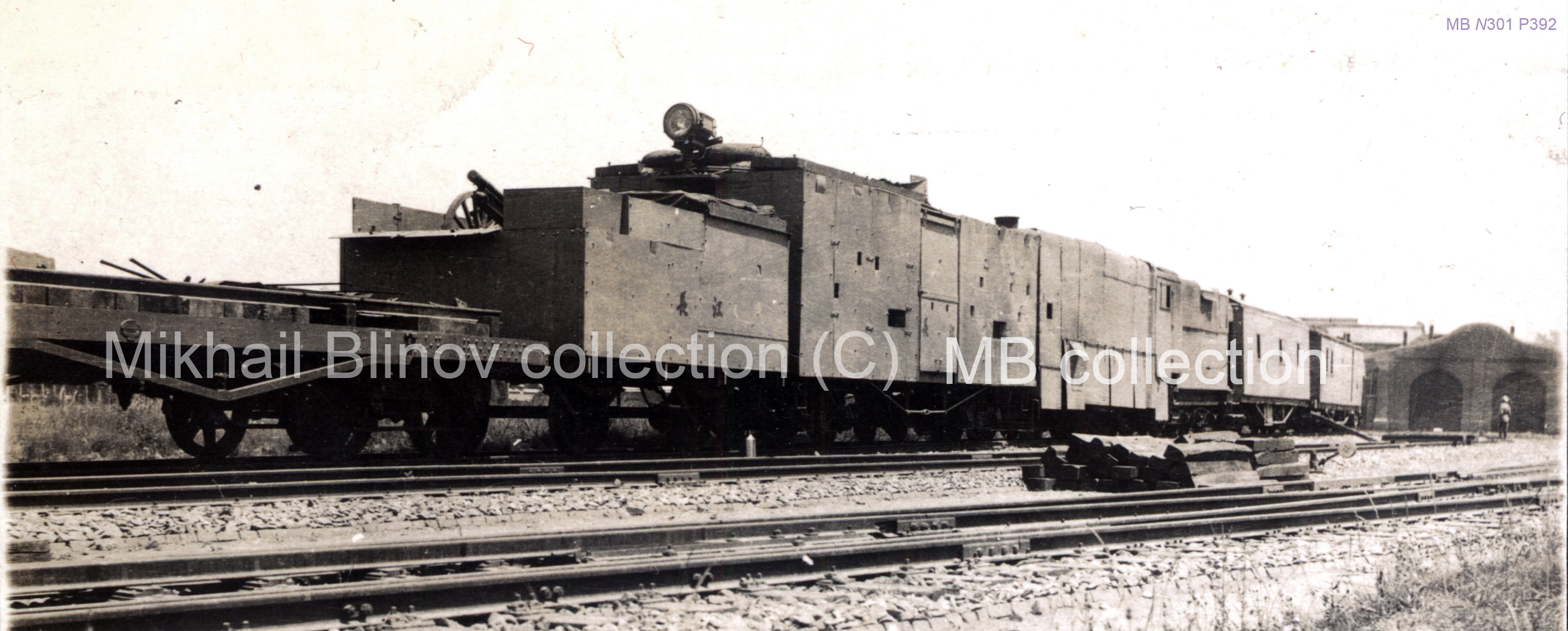
The first armored trains of the early “box” type (Possibly the “Chang Cheng” or Great Wall) 1925 Tsinan depot (N301 P391)
In January 1925, the Russian detachment went on the offensive to the south and occupied the Pukou station near Nanjing. Two armored trains took part in these battles, one of which, the Chang Chen (“Great Wall”), reached Shanghai.

The first “box” early type of armored trains before rebuilding, presumably “Henan” and the “Chang Cheng” (Great Wall), 1925 (N302 P506 fragment)
In the autumn of 1925, before the start of the campaign against Sung Chang Fang, the armored division was renamed the Special Armored Regiment under the command of Colonel Kostrov. The two divisions included four armored trains and worked in the Kaifeng station area on the coal mining railway line to the west of the highway to Nanjing – Shanghai.
Description of the battles and the first losses
In early November 1925, three armored trains were ordered to load a Chinese infantry regiment and move with it in the direction of Pukou until they came into contact with the enemy. There were small villages on the sides of the path. When two or three stations had passed, the rear armored train’s locomotive broke down and it began to give alarm horns. The front train stopped, the middle one took the rear one in tow and everyone retreated, since two armored trains were no longer fit for battle. During the return a landmine exploded on the railroad track at the Kuchen station and the escape route was cut off. Simultaneously with the explosion, enemy forces appeared from the forest on both sides of the road, surrounding the armored trains. Shelling began. The Chinese regiment started to shoot at the enemy from the trains. The Russian train crews jumped out and took up supporting positions around the armored trains, but in the chaos of battle, the Chinese regiment fired outwards indiscriminately, resulting in a frightening amount of friendly fire. The battle went on for 6 hours, evenly matched, back-and-forth, back-and-forth. The rifles had no bayonets.
As a result, not seeing an opportunity to fight off the numerically superior enemy, the Russians rushed a counterattack on foot and about 300 people miraculously made their way out under the command of Major Derektorsky. Later, Colonel Ganelin broke out of the encirclement. All three trains were destroyed. The command staff of the armored trains were killed, including General Kostrov, Colonel Bukas and Captain Chernyavsky. At the same time, some miles behind the encirclement a fourth armored train commanded by Captain Chernyavsky was brought up as a relief force. Alas, this train received grenade hits from the outer cordon of enemy troops and was sent away to the north for repair. On the way, the armored train failed to notice or stop in time for a dismantled bridge span and careened off at speed, falling from a significant height. The train cars cracked open and burst. Of the 100 people on the team, only 1 stoker escaped, but he was disabled for the rest of his life. The four wrecked trains were probably salvaged and taken back later by the Russians and used to restore or manufacture new armored trains built in late 1925 – early 1926.
After the destruction of these armored trains, by the beginning of 1926, four armored trains were built or restored at the factory in Jinan: “Shandong”, “Honan” and “Taishan” and “Changchen”. “Shandong” and “Honan” were initially sent to the southern front. With the beginning of the fighting against Fyn Yu-hsiang in February 1926, the Russian division plunged into echelons and moved as a whole to the northern front, including the Shandong and Honan armored trains. Later, a third armored train joined them.
In early March, during the fighting near the Canal, the enemy used aircraft in the area of the railway station. Like a response, the Russians installed a 75 mm anti-aircraft cannon on the armored train. In April, the armored trains took part in the capture of Beijing, mainly in reconnaissance-in-force roles. After the victories on the northern front, the units returned to the base in Jinan, where new armored trains continued to be built.
The structure of the Russian division of armored trains as of October 1926:
– 1 brigade (headed by Major General Chekhov):
— “Pekin” (“Beijing”), “Taishan”,
– 2 Brigade (Chief General Liu Shian):
— “Henan” (or Honan, major-Repchansky), “Shandong”
– 3 Brigade (General Yang Tayu):
— “Great Wall” (“Chan Chen” or Chángchéng), “Great River” (Chángjiāng)
- Armored train “Henan” after modernization (N 303)
- “Box” cars before modernization, compare with other photos (N 304)
- Armored train “Henan” (MB N 305 P507)
- Russian armored train in Chinese Civil War (M.B. collection)
- “Beijing” 1926 or 27, is the best armored train modeled like the First World War (“Hunhuz”), also known as the Czech “Orlik” (N 306)
- Armored train “Peking” (“Beijing”) and its crew, 1926 or 1927. Pay attention to the armor near the machine gun loopholes (N 307)
Armored Trains Against the Northern Expedition
In March 1927, an offensive began on Nanking, against the troops of Chiang Kai-shek, which were then considered as pro-communist and had Soviet instructors. The four armored trains “Taishan”, “Henan”, “Shandong” and “Chang-chen” advanced to the southern front with the goal of reaching Pukou on the banks of the Yang-tse-pu near the city of Nanjing. The old dilapidated railway was the same one used on campaign near Fulichi in 1925. The enemy retreated, dismantled the tracks, which the crews of the armored trains had to repair. In the area of the Grand Сanal “Taishan” successfully destroyed an enemy fortress, and the artillery officer who distinguished himself personally received a promotion to captain and the Order of the Fat Ear (Spica / Spike) from Zhang Zuchang. The armored train “Chan Chen” was later tasked with repairing the local bridge.
On the banks of the Yangtze River lies the city of Pukou, where there is a large station and a pier. Chang-chen, being lighter, crossed over the bridge and advanced on Shanghai. In late spring of 1927, however, Chiang Kai Sheek concluded an agreement with Fyn-yu-hsiang against Shen-si, and the “northern” group of Zhang Zuchang began to retreat, ending the offensive campaign against the Northern Expedition.
After a 350 km retreat, the armored trains went back to retake Pukou, and turned onto the branch line on Luoyang against Feng Yu Xiang. Here the tragedy of 1925 was repeated and the armored trains were encircled and destroyed.
- Map of the battles of the Russian detachment in 1926 – 1927
This article will be expanded at a later date.
The article by Mikhail Blinov uses the photographs from the the personal photo archive of the chief of staff of Russian armored trains, Colonel Boris Popov. After his dismissal from the Chinese service, Popov went to serve in the municipal police of the French concession in Shanghai. After the Second World War, in 1949-1951, Popov, along with refugees from China, lived in the DP camp on the island of Tubabao, Philippines. Then he moved to the USA, where he was the Chairman of the Society of Russian Veterans of the First World War in the city of San Francisco, California.

